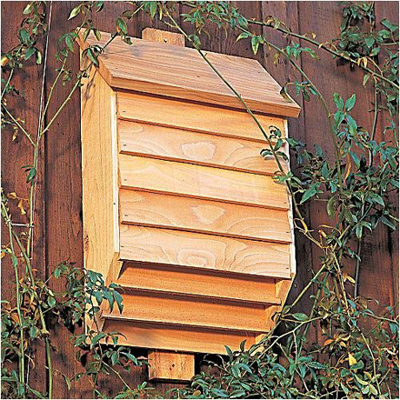
By Luke Anderson
I grew up living in the middle of nowhere, so I’m used to dealing with bugs and strange creatures. Of course, no one likes mosquitoes, since they leave you with itchy little bumps. There are plenty of contraptions that promise to rid your yard of the pests, but few actually perform. So what if I told you there was something that was proven to get rid of up to 600 bugs per hour? Would you want something like that in your yard? What if I told you that bug-killer was a bat?
Yes, the average bat will eat around 600 bugs, including mosquitoes, per day (or night rather). With a simple Bat Conservatory you keep a few bats hanging around (bad pun alert!) your yard , and thus keeping the area bug population at a minimum. If you don’t mind the bats being around at night, then install this Bat Conservatory made from Western Red Cedar for around $55.






Um… K…
So how are you suppose to get 40 bats in there? Do you have to buy them or do they just show up like birds to bird houses?
In North Carolina in my back yard I occasionally see bats at twilight. Most people assume they are birds, but you can tell by their fast and mildly erratic wingbeat that they are bats. I wouldn’t mind putting this on a tree facing away from my house for the mosquito benefits, but my concern would be smell from the guano that would build up on it or under it. Anyone have one of these and care to comment?
There are plenty of contraptions that promise to rid your yard of the pests.
I was a bat conservation volunteer before I emigrated so I will share a few considerations….
It can take a few years before bats move in – they are much more fickle than birds and usually return to established roosts.
Bats have different types of roosts – winter / summer / maternity.
Bats eat their body weight in mosquitoes/insects each night and are a valuable part of the ecosystem.
Bats are also struggling, much like the Monarch butterflies and the honey bees, so they need all the help we can give them.
Placement of a bat house is important – there must be a good, clear drop beneath it so the bats can ‘let go’ and fall into a glide to get ‘up and away’.
Preferably place it facing south.
Check periodically for wasp nests etc and remove (bats will not move in if it is occupied).
Never paint / treat the interior (especially do not spray with insect killer).
Once bats have moved in, DO NOT DISTURB.
Check online for a local bat conservation contact and keep it handy, in case you find a sick or injured bat near the roost.
Bats can carry rabies and other diseases, so always wear gloves and avoid contact.
Guano will accumulate below the roost but will not be much (it takes years and years to accumulate to what you see on TV!) – and can be cleared up – it makes good fertilizer!
Hope that helps 🙂
We’re so going to do this when we move into the house, we can’t at the moment as we rent. I love bats!
If you have bats anywhere in the area they will come by and check it out and most likely move in.